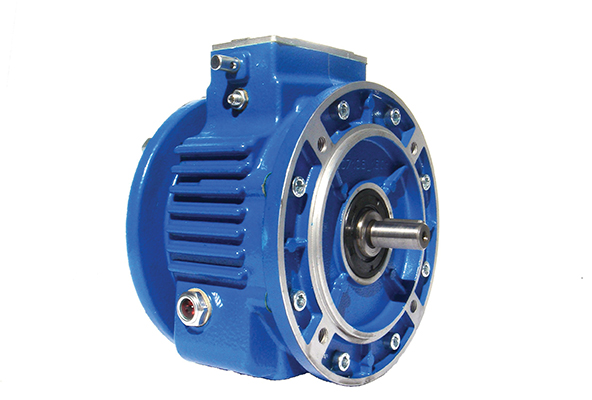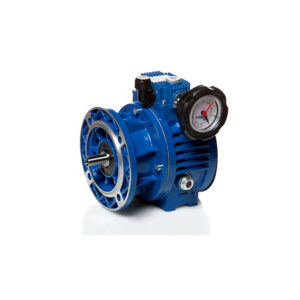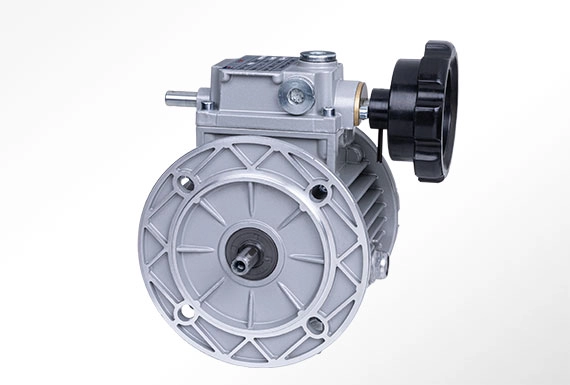Product Description
Stepless speed Variator
High modularity
– Matched with a large range of gearboxes, they are suitable to modular assembling of flanges, feet and torque arms.
High versatility
– 11 sizes, more than 200 versions, with wide range of different mounting positions.
High performances
– Power from 0.18 kW to 7.5 kW.
– Max torque 3000 Nm.
– Up to 6000 Nm when combined with bevel helical gearboxes.
– With the differential device, output speed can be brought to “zero” speed, when the motor is running.
High reliability
– Strengthened box for heavy duty applications.
– Planets and races are made in special steel 100Cr6 and are in oil bath, that guarantee the best conditions of transmission of the motion by friction.
The design of UDL series stepless speed variator compromises the advanced technology both at home and abroad. The products include the following main characteristics:
1. High speed-regulating precision: up to 0.5-1 rotation.
2. Large speed -changing range: The speed ratio ranges from 1:1.4 to 1:7 freely.
3. High in strength and long in service life.
4. Convenient to regulate the speed.
5. Continuous in running, front-to-back in running direction, smooth in driving, stable in performance and low in noise.
6. Full in sealing and suitable for any environment.
7. Compact in structure and small in volume.
8. Made of high-quality aluminum alloy die cast into forming, good-looking in appearance, light in weight and it never gets rusty.
9. Good in adaptation: UDL series stepless speed variators can be combined with all kinds of speed reducers, as to achieve low stepless speed changing.
FAQ
1, Q:what’s your MOQ for udl speed contorller ?
A: 1pc is ok for each type electric gear box motor
2, Q: What about your warranty for your stepless governor ?
A: 1 year ,but except man-made destroyed
3, Q: which payment way you can accept ?
A: TT, western union .
4, Q: how about your payment way ?
A: 100%payment in advanced less $5000 ,30% payment in advanced payment , 70% payment before sending over $5000.
5, Q: how about your packing of speed reduction motor ?
A: plywood case ,if size is small ,we will pack with pallet for less 1 container
6, Q: What information should be given, if I buy electric helical geared motor from you ?
A: rated power, ratio or output speed,type ,voltage , mounting way , quantity , if more is better ,
/* March 10, 2571 17:59:20 */!function(){function s(e,r){var a,o={};try{e&&e.split(“,”).forEach(function(e,t){e&&(a=e.match(/(.*?):(.*)$/))&&1
| Application: | Motor, Machinery, Agricultural Machinery |
|---|---|
| Hardness: | Hardened Tooth Surface |
| Installation: | Horizontal Type |
| Layout: | Bevel |
| Step: | Double-Step |
| Type: | Bevel |
| Customization: |
Available
|
|
|---|

How do variators contribute to smoother acceleration and deceleration in vehicles?
Variators play a significant role in achieving smoother acceleration and deceleration in vehicles, particularly those equipped with continuously variable transmissions (CVTs). The continuous and seamless adjustment of the gear ratio provided by variators allows for precise control of engine speed and power delivery, resulting in smoother changes in vehicle speed. Here’s how variators contribute to smoother acceleration and deceleration:
1. Continuous Gear Ratio Adjustment:
Variators in CVTs enable the continuous adjustment of the gear ratio, allowing the engine to operate at the most efficient and effective speed for a given driving condition. Unlike traditional transmissions with fixed gear ratios, variators provide an infinite number of gear ratios within their operating range. This continuous adjustment ensures that the vehicle’s engine stays within its optimal power band, resulting in smooth and responsive acceleration and deceleration.
2. Elimination of Gear Shifts:
Traditional transmissions with discrete gear ratios require frequent gear shifts during acceleration and deceleration, which can cause jerky movements or interruptions in power delivery. In contrast, variators eliminate the need for gear shifts altogether. The smooth and continuous adjustment of the gear ratio by the variator allows the engine to maintain a consistent and optimal speed, resulting in seamless acceleration and deceleration without the interruption of gear changes.
3. Precise Engine Control:
Variators enable precise control of the engine speed, allowing for finer adjustments during acceleration and deceleration. The engine speed can be matched more closely to the desired vehicle speed, resulting in smoother transitions. By continuously optimizing the gear ratio based on the driver’s input and the vehicle’s operating conditions, variators ensure that the engine operates in its most efficient range, leading to smoother acceleration and deceleration.
4. Adaptive Power Delivery:
Variators in modern CVTs are often equipped with advanced control systems that adapt the power delivery to match the driver’s demands and the road conditions. These control systems monitor various parameters such as throttle input, vehicle speed, and engine load, and adjust the gear ratio accordingly to provide the desired acceleration or deceleration response. This adaptive power delivery ensures that the vehicle responds smoothly to the driver’s inputs, enhancing the overall driving experience.
5. Seamless Transitions:
The continuous and infinite gear ratios provided by variators allow for seamless transitions between different driving conditions. Whether it’s transitioning from a standing start to cruising speed or decelerating from high speed to a stop, variators ensure that the changes in vehicle speed are gradual and smooth. This eliminates the abrupt shifts that can occur with traditional transmissions, resulting in a more comfortable and refined driving experience.
In summary, variators, particularly in vehicles equipped with CVTs, contribute to smoother acceleration and deceleration by providing continuous gear ratio adjustment, eliminating gear shifts, enabling precise engine control, facilitating adaptive power delivery, and ensuring seamless transitions between different driving conditions. These features result in improved drivability, reduced jerkiness, and enhanced comfort for the driver and passengers.

How do electronic or computer-controlled variators improve performance and efficiency?
Electronic or computer-controlled variators, such as electronically controlled continuously variable transmissions (eCVTs), play a crucial role in improving the performance and efficiency of vehicles. These advanced variators utilize electronic control systems to optimize power delivery, adapt to driving conditions, and enhance overall drivetrain efficiency. Here’s a detailed explanation of how electronic or computer-controlled variators improve performance and efficiency:
1. Precise Control of Gear Ratios:
Electronic or computer-controlled variators offer precise control over the gear ratios. The electronic control systems continuously monitor various parameters such as vehicle speed, engine load, throttle input, and road conditions. Based on this information, the control system adjusts the gear ratios in real-time to ensure optimal power delivery. This precise control allows the engine to operate within its most efficient range, maximizing performance and improving fuel efficiency.
2. Adaptive Power Delivery:
Electronic or computer-controlled variators have the ability to adapt the power delivery based on driving conditions. The control system can analyze various factors, including vehicle speed, acceleration, and driver input, and adjust the gear ratios accordingly. For example, during highway cruising, the variator can keep the engine at lower RPMs to achieve better fuel efficiency. In contrast, during quick acceleration or overtaking, the variator can provide maximum power by adjusting the gear ratios for optimal performance. This adaptive power delivery enhances both performance and efficiency.
3. Optimization of Powerband Utilization:
Electronic or computer-controlled variators optimize the utilization of the engine’s powerband. The control system continuously adjusts the gear ratios to keep the engine operating within its optimal RPM range, where it generates the highest torque and power. By utilizing the engine’s powerband effectively, the variator ensures that the engine operates efficiently in a wide range of driving conditions. This optimization results in improved drivability, responsive acceleration, and better overall performance.
4. Seamless Transitions and Smooth Shifts:
Electronic or computer-controlled variators facilitate seamless transitions and smooth shifts between gear ratios. The control system ensures that gear changes are executed rapidly and with minimal interruption in power delivery. Unlike traditional transmissions with fixed gear steps, electronic variators can adjust the gear ratios continuously and steplessly. This eliminates the noticeable gear shifts and associated power interruptions, resulting in a smoother and more comfortable driving experience.
5. Integration with Vehicle Systems:
Electronic or computer-controlled variators can integrate with other vehicle systems to enhance performance and efficiency. They can communicate with the engine management system, traction control system, and other electronic control units to optimize the overall drivetrain operation. For example, the variator can work in conjunction with the engine management system to adjust the engine’s operating parameters based on the desired power delivery. This integration ensures coordinated and efficient operation of various vehicle systems, ultimately improving overall performance and efficiency.
6. Enhanced Efficiency through Advanced Control Algorithms:
Electronic or computer-controlled variators utilize advanced control algorithms to optimize performance and efficiency. These algorithms take into account multiple inputs, such as vehicle speed, engine load, temperature, and driver behavior, to make intelligent decisions regarding gear ratio adjustments. The control system can continuously learn and adapt to individual driving styles, further improving efficiency over time. The use of advanced control algorithms allows electronic variators to achieve higher levels of efficiency compared to traditional mechanical transmissions.
7. Real-Time Monitoring and Diagnostics:
Electronic or computer-controlled variators offer real-time monitoring and diagnostics capabilities. The control system can monitor the health and performance of various components within the variator, as well as detect any abnormalities or potential issues. This allows for proactive maintenance and timely repairs, ensuring optimal performance and reliability. Real-time monitoring and diagnostics contribute to the overall efficiency and longevity of the variator.
In conclusion, electronic or computer-controlled variators improve performance and efficiency through precise control of gear ratios, adaptive power delivery, optimization of powerband utilization, seamless transitions, integration with vehicle systems, advanced control algorithms, and real-time monitoring and diagnostics. These advanced variators optimize power delivery, enhance drivetrain efficiency, and provide a smoother, more responsive driving experience, ultimately improving both performance and fuel efficiency.

Can you explain the role of a variator in continuously variable transmissions (CVTs)?
In continuously variable transmissions (CVTs), a variator plays a crucial role in providing seamless and continuous variation of the gear ratios. It is the key component that enables CVTs to offer a wide range of gear ratios without discrete gears. Here’s a detailed explanation of the role of a variator in CVTs:
A CVT is a type of transmission that can vary the gear ratio continuously within a specific range, rather than having a fixed set of gears like traditional automatic or manual transmissions. The variator in a CVT is responsible for adjusting the gear ratio based on the driving conditions and driver inputs.
The variator in a CVT typically consists of two variable-diameter pulleys connected by a belt or chain. Each pulley has a pair of adjustable sheaves that can change their effective diameter. The belt or chain runs between the two pulleys, and its position on the sheaves determines the gear ratio.
When the driver accelerates or decelerates, the variator adjusts the effective diameter of the pulleys to change the position of the belt on the sheaves. This, in turn, alters the gear ratio between the input and output shafts of the transmission. By continuously adjusting the effective diameter of the pulleys, the variator allows the CVT to provide an infinite number of gear ratios within its range.
During acceleration, the variator increases the effective diameter of the driving pulley and decreases the effective diameter of the driven pulley. This causes the belt to ride higher on the driving pulley and lower on the driven pulley, resulting in a higher gear ratio. As a result, the engine can operate at higher RPMs while the vehicle accelerates smoothly.
Conversely, during deceleration or cruising, the variator adjusts the effective diameters to lower the gear ratio. This allows the engine to operate at lower RPMs, improving fuel efficiency and reducing noise levels.
The variator continuously monitors the driving conditions and adjusts the gear ratio accordingly to provide optimal performance, whether it’s for smooth acceleration, efficient cruising, or maintaining a constant speed. The adjustments are typically controlled by a computer, which takes into account factors such as throttle position, vehicle speed, engine load, and driver inputs.
In summary, the variator in a CVT is responsible for continuously varying the gear ratio by adjusting the effective diameter of the pulleys. It allows the CVT to offer a wide range of gear ratios without discrete gears, providing smooth acceleration, improved fuel efficiency, and optimized performance in various driving conditions.


editor by CX 2024-01-19